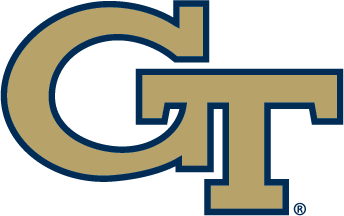Aug. 7, 2017
The Good Word | By Jon Cooper
Roger Anderson just had a feeling.
That means something when you’re talking about one of the Georgia Tech men’s tennis program’s most decorated players who currently develops rising female players for the United States Tennis Association (USTA). As usual, his feeling was on the mark.
“I did think about it actually at the beginning of this year,” Anderson said. “It was a thought. I was like, ‘I think I’d be a good contender.’ Funny how then the same year it actually happened.”
Anderson is part of a talented sextet comprising the Georgia Tech Athletics Hall of Fame Class of 2017. He joins a group that includes Durant Brooks (football), Roberto Castro (golf), B.J. Elder (basketball), Ashley Kidd (track and field), and Matt Wieters (baseball) as part of the class that will be inducted on Friday, Sept. 22, at the College Football Hall of Fame as part of Hall of Fame Weekend.
Anderson’s thought of immortalization from his alma mater, while passing and, quite uncannily timed, is justified. The native of Pietermaritzburg, South Africa, came to the Flats in 2000 and for four years was a dominant force, who’s still in the top 10 in several categories.
He ranks fifth in singles wins (90), is tied for eighth in dual match wins (54, coincidentally with head coach Kenny Thorne, who recruited him), is tied for tenth in single-season wins (28), and is tenth in winning percentage (.760). He was a three-time all-ACC selection, an ITA all-American honoree and the ITA Region Senior Player of the Year in 2003 and the first Yellow Jacket to win ACC Rookie of the Year.
His place in Tech history almost never happened.
“About a month before school started I hadn’t planned on going to any university. I was going to go pro,” Anderson recalled. “Andy Roddick’s coach, who was also my coach — we trained together — knew Coach Thorne and he called up Coach Thorne and said, ‘I have a player for you. Do you want to take him?’ Coach Thorne, without seeing me play, just said, ‘Yes.’ That was that.”
Anderson admits that Thorne took something of a risk in signing him, sight unseen, but was confident he’d deliver.
“You want to see somebody play but it was still going to be a good choice for him,” he said. “I was the top-ranked junior in the world so it was pretty much a good deal for him, I think.”
Anderson didn’t give anyone a reason to second-guess the decision. From his first match, on Feb. 27, 2000 at the Bill Moore Center against Vanderbilt he showed he’d be a big-time player. In that match, he pulled out a three-set win over Vandy’s Peter Blach, to clinch the match for the Jackets, and end a five-match losing streak.
“I can still remember my first match against Vanderbilt. I clinched the match for our team, 7-5 in the third set,” he recalled. “That was a really good start and first experience in college tennis, clinching the match for our team in such a thrilling third set.
“That got me really loving the whole set-up and format in college tennis,” he added. “Coach Thorne gave me the opportunity to play high up in the lineup which exposed me to some of the best players in the country. Just having that opportunity really motivated me to want to do well.”
He would lead the team in wins a freshman, going 15-5 in singles and tying for the team lead in doubles wins, as he and partner David Wright went 8-5. He would be named ACC Rookie of the Year, the first Yellow Jacket ever to win the award and only one of two ever do do so (Guillermo Gomez also won it 2008).
Anderson admitted the award was small consolation, as the Jackets finished 10-13 (4-4 in ACC play), and did not participate in the NCAA Tournament.
He would do something about that, and, the Jackets, with him at the top of the lineup, would neither have another losing season nor miss the NCAA Tournament again while he was on the team.
In 2001, Anderson was 16-9 in dual matches (29-15 overall), he and Wright would again lead the team in doubles wins, with a 14-9 record (Anderson was 18-13 overall). The Jackets turned things around, going 17-7 (6-2 in ACC play) and qualified for the NCAAs, where they topped Arizona, 4-2, in the first round, before falling to Georgia, 4-0.
The following season, the Jackets played giant-killer, beating eight nationally ranked teams and getting to the finals of the ACC Tournament. Maybe the biggest giant the team Tech felled was No. 14 Duke in the semifinals of the ACCs, ending the Blue Devils four-year run as conference champions. They would fall to North Carolina in the finals but returned for the NCAAs, before falling in the first round. Anderson was 11-9 in dual match play, 23-10 overall, and he and Scott Schnugg led the team in doubles wins, going 13-2 (14-3 overall).
Anderson would save the best for last, as in 2003, he went 23-9 playing at No. 1, while in doubles, he and Schnugg were named All-ACC and All-Americans, finishing as the 10th ranked pair in the country. Georgia Tech knocked off seven ranked teams, including No. 9 Texas, 4-2, and earned a spot in the NCAA Tournament, reaching No. 14. Anderson even got to play in the NCAA Tournament, but fell in the first round.
“It was very special for me to reach the NCAA Divisional Final just because there weren’t many players from Georgia Tech that had individually been very successful,” he said. “It was also different because you’re in the team environment the whole time and although tennis is an individual sport you don’t really feel like you’re playing an individual sport when you’re playing college tennis. So to go out and play the NCAA Tournament was actually quite nice to remember that tennis IS an individual sport.”
Anderson graduated then, turned pro and after a brief playing career, would find his niche as a coach. The move to coaching began quite randomly in 2006, after playing a match against former World No. 1 Martina Navratilova as part of World Team Tennis — the match “didn’t go too well for me, I respected her too much,” he recalled with a laugh.
“She gave me a call. about three or four months later, just asking if I would be interested to travel with her,” he recalled. “I was playing professionally, still, when she asked me to work with her. I thought I’d just do it for the one year she wanted and then I would continue my career. But after working with her, I’ve been on the women’s tour every single day for the last 12 years.”
Things went well that year, Navratilova, 49, won the U.S. Open Mixed Doubles championship with Bob Bryan, and have gone quite well ever since.
Anderson would coach four other top-10 players/teams — Nadia Petrova, a Russian player, who got to No. 6, Patty Schnyder, a Swiss player, who got to No. 9 with Anderson, the doubles team of Liezel Huber and Cara Black, which won the U.S. Open doubles in 2008, and Sania Mirza, the current No. 1 doubles player in the world. He cites one of his greatest success stories as fellow South African, Chanelle Scheepers. He helped her reach No. 37 in the world and, most important, marrying her on Nov. 10, 2012.
For the last four years, Anderson has coached with the USTA, where he works with rising players ranked from 30 to 150, including current protege Jennifer Brady, who played well at Wimbledon before falling in the second round to world No. 8 Dominika Cibulkova, 6-4, 6-4.
“I really like working and developing professional players, especially putting players into the top 100,” said Anderson, who calls Boca Raton, Florida home. “That’s sort of my speciality, getting them from 200 in the world into the top 100. I could see myself doing this for quite a while and, in the future, mentoring younger coaches.”
Anderson has kept an eye on Georgia Tech men’s tennis and current star Christopher Eubanks, who’ll begin his senior year tied with Anderson at 90 wins, is one dual win behind (53) and could make a run at passing him in career winning percentage (Eubanks is at 73.2 percent).
“It’s been great to follow Chris’ career at Georgia Tech,” he said. “I watched him at the U.S. Open qualifying last year in New York and he definitely has a great game. It doesn’t surprise me at all that he’s chalked up so many wins with the way he plays. He could have a good career as a professional afterwards. He seems like he’s a good team player and leader. It’s great for the program to have a big-time player like him.”
Anderson is eager to attend the Hall of Fame induction and return to campus to see the new Byers Tennis Complex and re-live some great days and great memories, more involving his teammates, not revolving around him.
That’s what he most remembers about his college days.
“The team, the unity we had within the team, the discipline and work ethic from our leader, Coach Thorne, and just the desire to win together as a team rather than individually were the great things,” he said. “There was more joy and satisfaction winning as a team than any individual milestone.”
Of course, he’s excited about joining his new team in the Class of ‘17.
“I was in South Africa on vacation on safari when I got the call,” he said. “I saw the 404 number and answered it. I was so happy. I was thinking about it the whole time afterward. I’m really thrilled to be part of this club.”









